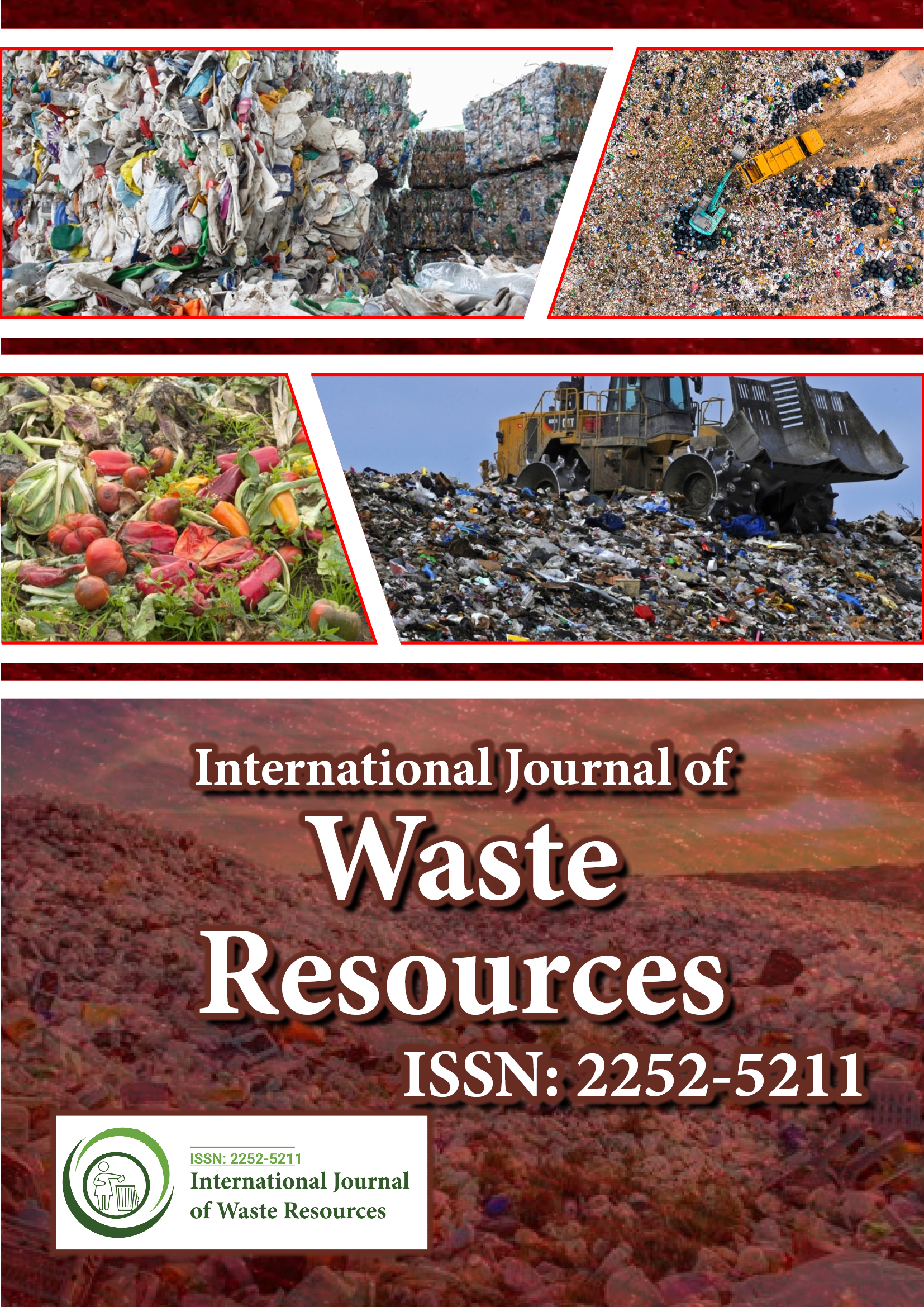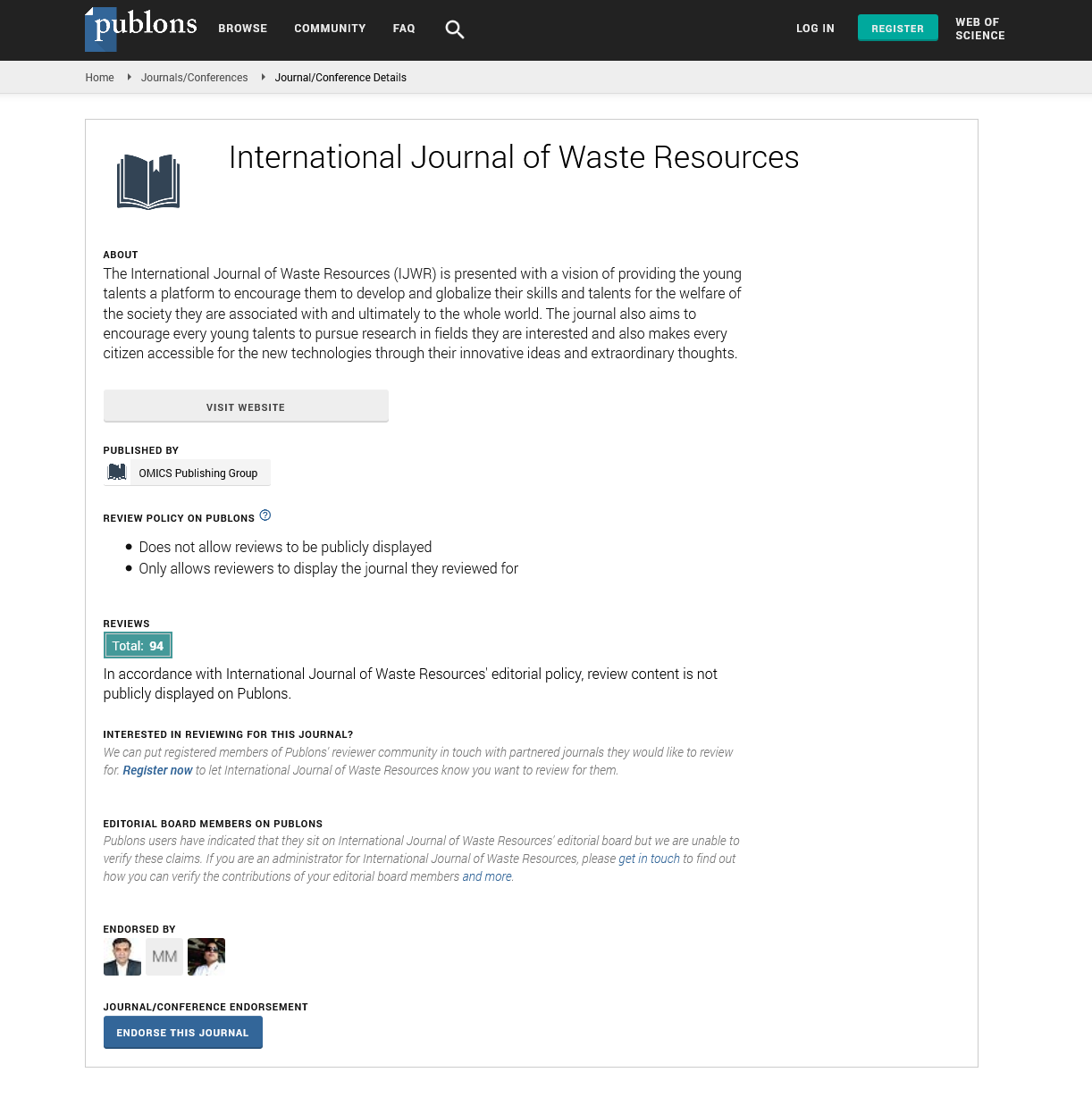Indexed In
- Open J Gate
- The Global Impact Factor (GIF)
- Open Archive Initiative
- VieSearch
- International Society of Universal Research in Sciences
- China National Knowledge Infrastructure (CNKI)
- CiteFactor
- Scimago
- Ulrich's Periodicals Directory
- Electronic Journals Library
- RefSeek
- Directory of Research Journal Indexing (DRJI)
- Hamdard University
- EBSCO A-Z
- Publons
- Google Scholar
Useful Links
Share This Page
Journal Flyer

Open Access Journals
- Agri and Aquaculture
- Biochemistry
- Bioinformatics & Systems Biology
- Business & Management
- Chemistry
- Clinical Sciences
- Engineering
- Food & Nutrition
- General Science
- Genetics & Molecular Biology
- Immunology & Microbiology
- Medical Sciences
- Neuroscience & Psychology
- Nursing & Health Care
- Pharmaceutical Sciences
Opinion Article - (2025) Volume 15, Issue 1
Comprehensive Solid Waste Management: Strategies for a Cleaner Environment
Mogen Aufarth*Received: 31-Jan-2025, Manuscript No. IJWR-25-29250; Editor assigned: 03-Feb-2025, Pre QC No. IJWR-25-29250; Reviewed: 14-Feb-2025, QC No. IJWR-25-29250; Revised: 21-Feb-2025, Manuscript No. IJWR-25-29250; Published: 03-Mar-2025, DOI: 10.35248/2252-5211.25.15.604
Description
Solid waste management is the systematic approach to handling the generation, storage, collection, transportation, processing and disposal of solid wastes. As urbanization accelerates and population densities increase, managing this ever-growing volume of waste has become one of the most pressing environmental challenges globally. Proper solid waste management is essential for protecting public health, conserving resources and reducing environmental degradation. Addressing this issue requires not just technical solutions but also community involvement, regulatory enforcement and strategic planning.
Solid waste comes in various forms. Everyday waste generated from households, offices and commercial establishments is known as municipal solid waste. Industries contribute through manufacturing byproducts, while the healthcare sector produces biomedical waste, which contains potentially infectious or hazardous materials. Construction and demolition activities leave behind rubble, debris and other forms of solid waste and certain industrial and household activities also produce hazardous waste that is toxic, reactive, or flammable. Identifying and classifying these types of waste is crucial to implementing effective management strategies tailored to each category.
The process of managing solid waste begins with its generation. Waste originates from homes, businesses, agriculture and institutions. Reducing waste at its source through changes in consumption habits or product design can significantly lighten the burden on management systems. Once generated, waste must be stored properly at the source to prevent littering, odors and the spread of disease. This often involves using bins that separate waste by category, which greatly aids in recycling and composting efforts later in the process.
Efficient collection and transportation are vital to ensuring that waste reaches treatment or disposal sites in a timely and hygienic manner. This requires well-planned routing, scheduling and appropriate vehicles to handle different types of waste. Once collected, waste is processed and treated to reduce its volume and harmful impact. This stage may involve recycling, composting, incineration, or conversion into energy. Each method serves a different purpose: recycling recovers valuable materials such as plastics and metals, composting turns organic waste into soil enhancers and advanced thermal treatments transform waste into usable energy or fuel.
The final step in the solid waste management process is disposal, typically in landfills or incinerators. Modern landfills are engineered with liners and leachate treatment systems to minimize environmental contamination. When managed properly, they provide a necessary solution for non-recyclable and residual waste. However, disposal should always be the last resort, following efforts to reduce, reuse and recycle.
Despite progress in technology and policy, several challenges continue to hinder the effectiveness of solid waste management. Rapid urban growth increases the volume and complexity of waste, while many regions still lack the infrastructure to collect and process it properly. Financial constraints often limit access to modern technologies and public awareness about proper waste disposal remains low in many areas. Moreover, unmanaged or poorly handled waste contributes significantly to environmental pollution, greenhouse gas emissions and health risks.
Improving solid waste management requires a multifaceted approach. Reducing waste at the source through mindful consumption, coupled with proper segregation of recyclables, organics and hazardous materials, enhances the efficiency of downstream processes. Public participation is crucial and can be promoted through education and awareness campaigns. Policy and regulation must be enforced consistently to ensure compliance, while the adoption of innovative technologies can make waste processing more efficient and sustainable. The concept of integrated waste management, which combines various methods tailored to specific local needs, offers a flexible and holistic solution to complex waste problems.
Government plays a critical role by investing in infrastructure, enforcing environmental laws and creating incentives for sustainable practices. At the same time, communities can take ownership through local initiatives, cooperative recycling efforts and waste reduction campaigns. When citizens are empowered and informed, they become active participants in building cleaner cities.
Looking ahead, several promising trends are shaping the future of solid waste management. The shift toward circular economy models encourages the design of products that can be reused, repaired, or recycled, minimizing overall waste generation. The use of smart technologies, including devices and artificial intelligence, enables real-time monitoring and optimization of waste collection and processing. Some cities are even adopting zero-waste goals, aiming to eliminate landfill dependency through systemic innovation and behavioral change. Furthermore, integrating renewable energy systems with waste-to-energy technologies can enhance sustainability while generating power from waste.
Conclusion
Solid waste management is not just an environmental obligation it is a cornerstone of sustainable urban living. By integrating comprehensive strategies, embracing new technologies, enforcing robust regulations and encouraging widespread community engagement, societies can significantly reduce pollution, protect public health, conserve natural resources and create cleaner, more livable environments. Addressing the growing waste crisis today is essential for ensuring the health and sustainability of our planet for generations to come.
Citation: Aufarth M (2025). Comprehensive Solid Waste Management: Strategies for a Cleaner Environment. Int J Waste Resour: 15:604
Copyright: © 2025 Aufarth M. This is an open-access article distributed under the terms of the Creative Commons Attribution License, which permits unrestricted use, distribution and reproduction in any medium, provided the original author and source are credited.

